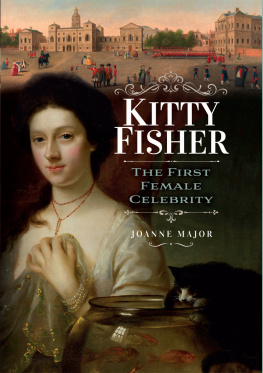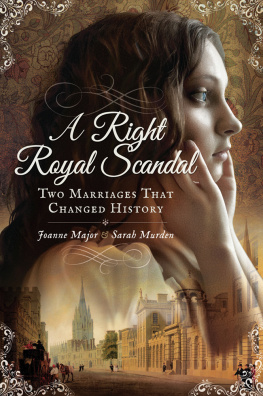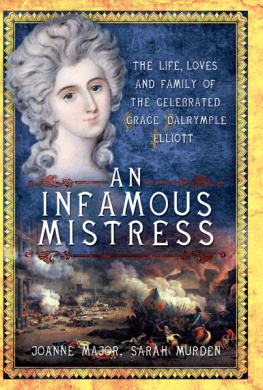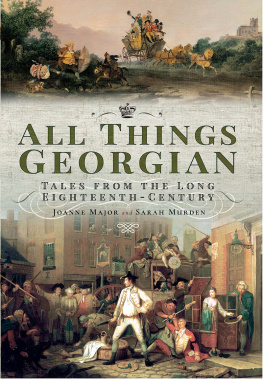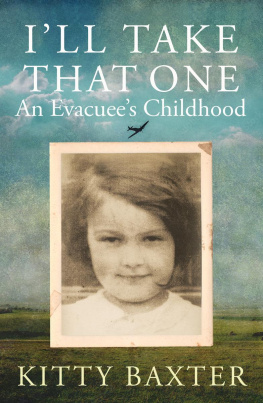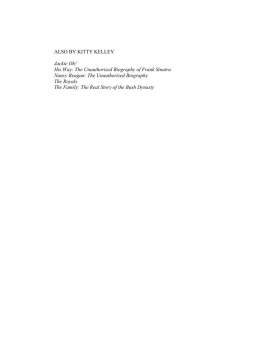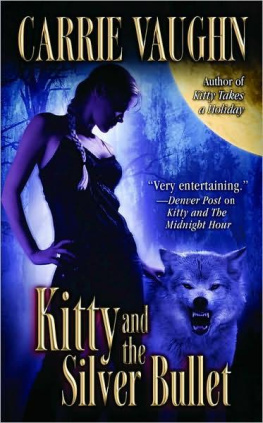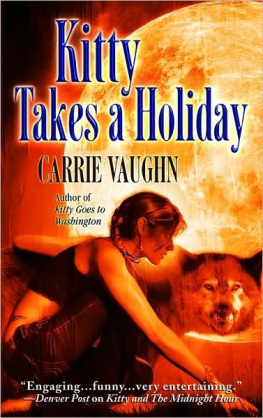Pagebreaks of the print version

Kitty Fisher
Kitty Fisher
The First Female Celebrity
Joanne Major
First published in Great Britain in 2022 by
Pen & Sword History
An imprint of
Pen & Sword Books Ltd
Yorkshire Philadelphia
Copyright Joanne Major 2022
ISBN 978 1 39900 697 2
Epub ISBN 978 1 39900 698 9
Mobi ISBN 978 1 39900 698 9
The right of Joanne Major to be identified as Author of this work has been asserted by her in accordance with the Copyright, Designs and Patents Act 1988.
A CIP catalogue record for this book is available from the British Library.
All rights reserved. No part of this book may be reproduced or transmitted in any form or by any means, electronic or mechanical including photocopying, recording or by any information storage and retrieval system, without permission from the Publisher in writing.
Pen & Sword Books Limited incorporates the imprints of Atlas, Archaeology, Aviation, Discovery, Family History, Fiction, History, Maritime, Military, Military Classics, Politics, Select, Transport, True Crime, Air World, Frontline Publishing, Leo Cooper, Remember When, Seaforth Publishing, The Praetorian Press, Wharncliffe Local History, Wharncliffe Transport, Wharncliffe True Crime and White Owl.
For a complete list of Pen & Sword titles please contact
PEN & SWORD BOOKS LIMITED
47 Church Street, Barnsley, South Yorkshire, S70 2AS, England
E-mail:
Website: www.pen-and-sword.co.uk
Or
PEN AND SWORD BOOKS
1950 Lawrence Rd, Havertown, PA 19083, USA
E-mail:
Website: www.penandswordbooks.com
For Oakley
Acknowledgements
W hen I started to research Kitty Fishers life, I had planned research trips to various areas of the country to consult archives, to view portraits, or to walk in Kittys footsteps. Then the pandemic hit and suddenly nothing was quite so simple. I would, therefore, like to thank the staff at numerous record offices, libraries, and art galleries who have supplied information remotely. In particular, special mention must go to the people whom I have pestered at the National Library of Scotland, Goldsmiths Library, Canterbury Museums and Galleries, Staffordshire Archives, and Kent Archives. Please know that I appreciate the time and trouble you have taken to answer my queries and in several cases to go above and beyond in your assistance.
I would also like to thank the staff on the Creative Writing degree programme at the University of Lincoln, Dr Christopher Dows, Dr Sarah Stovell, Dr Sue Healy, Dr Daniele Pantano, Dr Guy Mankowski, and Dr Amy Lilwall. Their advice, guidance, and excellent teaching have been invaluable. I am looking forward to beginning a Creative Writing MA with the University of Lincoln in 2022.
My thanks go to Sir William and Lady Proby for allowing me to reproduce their portrait of Kitty Fisher by Sir Joshua Reynolds, and to the staff of the Elton Estate Office. Also to Guy Innes and Alexandra Sheldon at Titsey Hall, who shared with me a great deal of information.
For their assistance in either answering my questions or digitising images (and sometimes for both!), I must also especially thank the relevant staff at the National Portrait Gallery, the Yale Center for British Art, the Lewis Walpole Library, and the Harvard Art Museums. My thanks also go to the other institutions who have made available their portraits and prints.
My publisher, Pen and Sword, has been, as always, amazing. Particular thanks go to Jonathan Wright and also to Charlotte Mitchell for her help and patience in dealing with my queries and emails. Also to my copy editor, Cecily Blench.
Lastly, I must mention my family for their support and encouragement whilst I lost myself in research and writing. My love and thanks go to my husband, Sam, my children, Luke and Aeron, and their partners, Chelsea and Sam. I couldnt have done this without you.
Introduction
All that we can know of her
Is this she was a milliner.
Her parentage so low and mean
Is hardly to be tracd, I ween:
Say, has she wit or has she sense?
No! nothing but impertinence.
( Kittys Stream , 1759)
T he eighteenth-century author who scribbled down these lines at the height of Catherine Maria Fischers fame was off the mark with his description. The vivacious Kitty Fisher, as Catherine Maria became known, was never impertinent except, perhaps, to her societys strict rules that governed and censured a womans conduct. As for wit, sense, and good humour, Kitty had those qualities in abundance. Added to which, she was kind-hearted and despite her profession as a courtesan possessed of innate elegance and modesty. Petite, with rich chestnut hair, cerulean blue eyes, and a retrouss (upturned) nose, Kitty was pretty rather than an exceptional beauty. It was her personality coupled with her looks that made her irresistible. Men wanted Kitty and women wanted to look like her. The incomparable Kitty Fisher was the eighteenth-century version of an it girl.
Catapulted into the public gaze after a horse-riding accident, Kittys world changed overnight. Before long, her name or rather, the pseudonym by which she became known would travel around the globe. It was a long way from her humble beginnings. Kittys family were working-class; her father was a London tradesman. Mr Fischers one great fault was that he idolised Kitty, his eldest child, to the point of ruin and the detriment of his business. He taught her to expect more than her parents frugal lifestyle. In doing so, Kittys father innocently set in motion a chain of events that led his daughter into a life of infamy. While still a teenager, Kitty became for a short but exhilarating period one of Londons most dazzling, iconic celebrities. She was a celebrated courtesan, a kept mistress who was adored and decried in equal measure. In contrast to her contemporaries, those other infamous ladies of the town, it is Kittys name that has echoed through the centuries. Incongruously, her notoriety survives in part via a childrens nursery rhyme: Lucy Locket lost her pocket, / Kitty Fisher found it, / not a penny was there in it, / only ribbon round it. For someone whose name is so well known today, little is remembered of her other than the scandal of her life, myths, and half-truths. It comes as something of a surprise to learn that Kittys career in the capitals upmarket sex trade was brief and that there is so much more of her story to tell. Like her father before her, Kitty had one crucial flaw, one that proved a big obstacle for someone in her profession. Kitty fell in love far too easily.
The purpose of this book is not to compare and contrast eighteenth-century attitudes to women in particular, those who earned their living in the sex industry with todays society. Kitty was a woman very much of her time, as were the men who paid her bills and bought her jewels. It was a licentious, lascivious era. If a woman of the town received a complimentary write-up in Harriss List of Covent-Garden Ladies (or A Man of Pleasures Kalendar ), the gentlemans handbook of the capitals whores, she viewed it as a success. Inclusion within the pages of Harriss List could lead to a position in one of the citys better brothels, or even the chance to be taken into keeping. Kitty never viewed herself as a common prostitute: she was a courtesan. Her ultimate aim was a marriage to a wealthy man and all the security which that would bring with it. If she gained a title into the bargain, then all well and good. While it was no small task, it was not out of reach. Before Kitty lay the examples of the well-born but penniless Gunning sisters, Elizabeth and Maria, who toyed with appearing on the stage of Dublins theatre. They both attracted the attention and hands in marriage of peers of the realm: James Hamilton, 6th Duke of Hamilton, and George William Coventry, 6th Earl of Coventry, respectively. Maria, Countess of Coventry, was Kittys greatest rival as well as a role model. There was also the flower girl and prostitute, Fanny Murray, who married twice; her first husband was a baronet who left her little but debts when he died, but with her second husband, an actor, Fanny had a long-lasting and happy, if otherwise unremarkable, marriage. Others in Kittys sphere did not fare so well; Nelly OBrien was the talk of the town for a while and gave the Earl of Thanet three sons, but was dismissed from his house when he married a titled lady instead. Lucy Cooper was immortalised in verse as that damnation whore of hell and neither snared a husband nor thought to save for the days when her looks began to fade and she was eclipsed by younger rivals. She ended her days in squalid penury, incarcerated in a debtors prison. At a time when opportunities for women were limited, the sex industry offered a route to independence or marital security and sometimes, for the lucky few, to both.

